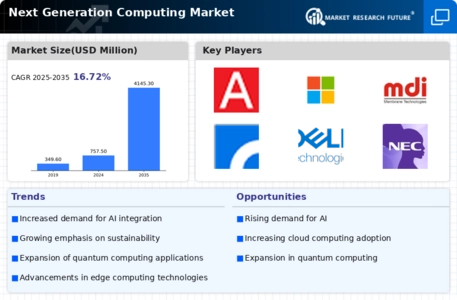Market Trends
Key Emerging Trends in the Next Generation Computing Market
The market trends of the next generation computing market are indicative of a transformative shift in the technological landscape. With the advent of breakthroughs such as quantum computing, edge computing, and artificial intelligence (AI), the market is witnessing a profound evolution. Quantum computing, in particular, is poised to revolutionize industries by exponentially increasing computational power, enabling solutions to complex problems that were previously insurmountable. This technology holds promise for fields like drug discovery, cryptography, and optimization, where massive data processing is essential.
Moreover, edge computing is gaining traction as organizations seek to process data closer to its source, reducing latency and improving efficiency. This trend is driven by the proliferation of Internet of Things (IoT) devices and the need for real-time data analysis in sectors such as healthcare, manufacturing, and autonomous vehicles. By decentralizing computation, edge computing enables faster decision-making and enhances user experiences.
In tandem with these advancements, AI continues to play a pivotal role in shaping the future of computing. Machine learning algorithms are becoming increasingly sophisticated, empowering businesses to extract valuable insights from vast amounts of data. From personalized recommendations in e-commerce to predictive maintenance in industrial settings, AI-driven solutions are driving innovation and improving productivity across various sectors.
Furthermore, the rise of cloud computing continues unabated, with organizations embracing hybrid and multi-cloud strategies to optimize performance and scalability. Cloud-native technologies enable seamless deployment and management of applications, facilitating agile development practices and cost-effective scalability. As businesses strive to adapt to rapidly changing market dynamics, cloud computing offers the flexibility and scalability needed to stay competitive.
Cybersecurity remains a paramount concern in the next generation computing landscape. With increased connectivity and data exchange comes the heightened risk of cyber threats. As such, there is a growing emphasis on integrating robust security measures into computing infrastructure, spanning from network security protocols to data encryption techniques. Organizations are investing in cybersecurity solutions to safeguard their digital assets and mitigate potential risks.
Moreover, sustainability is emerging as a key consideration in the next generation computing market. With the exponential growth of data centers and computing infrastructure, there is a growing awareness of the environmental impact associated with energy consumption and electronic waste. As a result, there is a concerted effort to develop energy-efficient computing technologies and implement sustainable practices across the entire computing ecosystem.










Leave a Comment